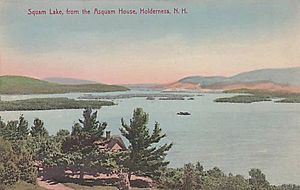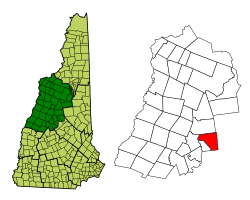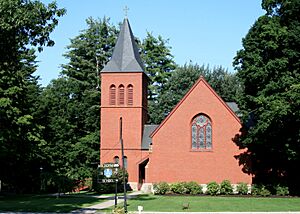Holderness, New Hampshire facts for kids
Quick facts for kids
Holderness, New Hampshire
|
||
|---|---|---|
|
Town
|
||

Squam Lake c. 1910
|
||
|
||

Location in Grafton County, New Hampshire
|
||
| Country | United States | |
| State | New Hampshire | |
| County | Grafton | |
| Incorporated | 1761 | |
| Named for | Robert Darcy, 4th Earl of Holderness | |
| Villages | Holderness East Holderness |
|
| Area | ||
| • Total | 35.7 sq mi (92.5 km2) | |
| • Land | 30.3 sq mi (78.6 km2) | |
| • Water | 5.4 sq mi (13.9 km2) 15.05% | |
| Elevation | 584 ft (178 m) | |
| Population
(2020)
|
||
| • Total | 2,004 | |
| • Density | 66/sq mi (25.5/km2) | |
| Time zone | UTC-5 (Eastern) | |
| • Summer (DST) | UTC-4 (Eastern) | |
| ZIP code |
03245
|
|
| Area code(s) | 603 | |
| FIPS code | 33-36900 | |
| GNIS feature ID | 0873627 | |
Holderness is a small town in Grafton County, New Hampshire, United States. About 2,000 people lived here in 2020. It's a lovely place known for its farms and as a fun spot for vacations.
Holderness is home to the Squam Lakes Natural Science Center. This center teaches people about nature. The town is also right on the beautiful Squam Lake. You can also find Holderness School here, which is a school where students live and get ready for college.
Contents
History of Holderness
Early Days and Naming
Long ago, the Squam Lakes were important travel routes. Native American tribes like the Abenaki and early European settlers used them. They traveled by river to reach the ocean.
In 1751, a group of people asked the governor for land. The town was named after Robert Darcy, 4th Earl of Holderness. He was an important person in England.
Settlement was delayed by a war. But in 1761, the land was given out again. The town was called "New Holderness" then. The first settlers arrived in 1763. By 1790, 329 people lived in the town. The "New" was dropped from the name in 1816.
Farming, Mills, and New Towns
Holderness started as a place for farming and fishing. There was also a busy area on the Squam River. This river had waterfalls that powered mills. This part of town became an industrial center.
A railroad arrived in 1849, bringing more business. But the mill area and the farming community didn't always agree. So, in 1868, the mill village became its own town called Ashland.
Holderness as a Resort Town
In the 1800s, visitors discovered the beautiful mountains and lakes. Before cars, they would take a train to Ashland. Then they would ride a steamer across Squam Lake. They stayed at fishing camps or hotels.
Today, Holderness is still a popular vacation spot. The famous movie On Golden Pond was filmed here in 1981. In 1924, a scientist named Katharine Harding Day studied birds here. She learned about a bird called the veery.
Geography and Nature
Holderness is located in the middle of New Hampshire. It's on the southeast edge of Grafton County. The town covers about 92.5 square kilometers (35.7 square miles). Most of this is land, but about 15% is water.
The Pemigewasset River forms the northwest border of Holderness. Owl Brook and the Squam River flow through the town. Part of Squam Lake is in the east. Little Squam Lake is in the center of town.
Mount Prospect is in the north, standing 584 meters (2,064 feet) tall. The highest point is Mount Webster. It is 633 meters (2,076 feet) high. All the water in Holderness flows into the Merrimack River.
Several main roads serve the town. These include U.S. Route 3 and state routes 25, 113, and 175.
Population and People
Holderness has grown over the years. In 1790, there were 329 people. By 2020, the population was 2,004.
Most people living in Holderness are White. A small number of people are African American, Native American, or Asian. Some people are of Hispanic or Latino background.
In 2000, about 30% of homes had children under 18. Most homes were married couples living together. The average age of people in Holderness was 42 years old.
The average income for a family in Holderness was about $55,526 in 2000. A small number of families and people lived below the poverty line.
Notable People from Holderness
Holderness has been home to several interesting people:
- George Butler (1943–2021), a filmmaker who made documentaries like Pumping Iron.
- Moses Cheney (1793–1875), who worked to end slavery and helped people escape on the Underground Railroad.
- Oren B. Cheney (1816–1903), who started Bates College.
- Arthur Livermore (1766–1853), a US congressman.
- Samuel Livermore (1732–1803), a US senator.
- Hercules Mooney (1715–1800), an officer in the Continental Army during the American Revolution.
- Lorenzo L. Shaw (1828–1907), a mill owner.
- May Rogers Webster (1873–1938), a naturalist who loved nature.
Places to Visit in Holderness
Many places in Holderness are listed on the National Register of Historic Places. This means they are important historical sites.
- Boulderwood, a private summer camp.
- Burleigh Brae and Webster Boathouse.
- Camp Carnes, a private summer camp.
- Camp Ossipee, a private summer camp.
- Chapel of the Holy Cross.
- Chocorua Island Chapel.
- Holderness Free Library.
- Holderness Inn.
- North Holderness Freewill Baptist Church–Holderness Historical Society Building.
- Rockywold–Deephaven Camps.
- Shepard Hill Historic District.
- Trinity Church.
- True Farm.
- Watch Rock Camp, a private summer camp.
- Webster Estate.

Images for kids
See also
 In Spanish: Holderness (Nuevo Hampshire) para niños
In Spanish: Holderness (Nuevo Hampshire) para niños





